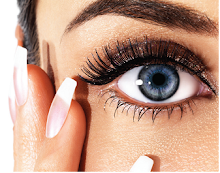Histologically, conjunctiva consists of three layers
namely, (1) epithelium, (2) adenoid layer, and (3)
fibrous layer (Fig. 1 below ).
1. Epithelium. The layer of epithelial cells in
conjunctiva varies from region to region and in its
different parts as
follows:
namely, (1) epithelium, (2) adenoid layer, and (3)
fibrous layer (Fig. 1 below ).
1. Epithelium. The layer of epithelial cells in
conjunctiva varies from region to region and in its
different parts as
follows:
- Marginal conjunctiva has 5-layered stratified squamous type of epithelium.
- Tarsal conjunctiva has 2-layered epithelium: superficial layer of cylindrical cells and a deep layer of flat cells.
- Fornix and bulbar conjunctiva have 3-layered epithelium: a superficial layer of cylindrical cells, middle layer of polyhedral cells and a deep layer of cuboidal cells.
- Limbal conjunctiva has again many layered (5 to 6) stratified squamous epithelium.
and consist s of fine connective tissue reticulum in
the meshes of which lie lymphocytes. This layer is
birth but develops after 3-4 months of life. For this
reason, conjunctival inflammation in an infant does
not produce follicular reaction.
3. Fibrous layer. It consists of a meshwork of
collagenous and elastic fibres. It is thicker than the
adenoid layer, except in the region of tarsal
conjunctiva, where it is very thin. This layer contains
vessels and nerves of conjunctiva. It blends with the
underlying Tenon's capsule in the region of bulbar
conjunctiva.




No comments :
Post a Comment
Waiting for your comments